ESP OLDSMOBILE SILHOUETTE 1994 Owners Manual
[x] Cancel search | Manufacturer: OLDSMOBILE, Model Year: 1994, Model line: SILHOUETTE, Model: OLDSMOBILE SILHOUETTE 1994Pages: 276, PDF Size: 15.82 MB
Page 6 of 276
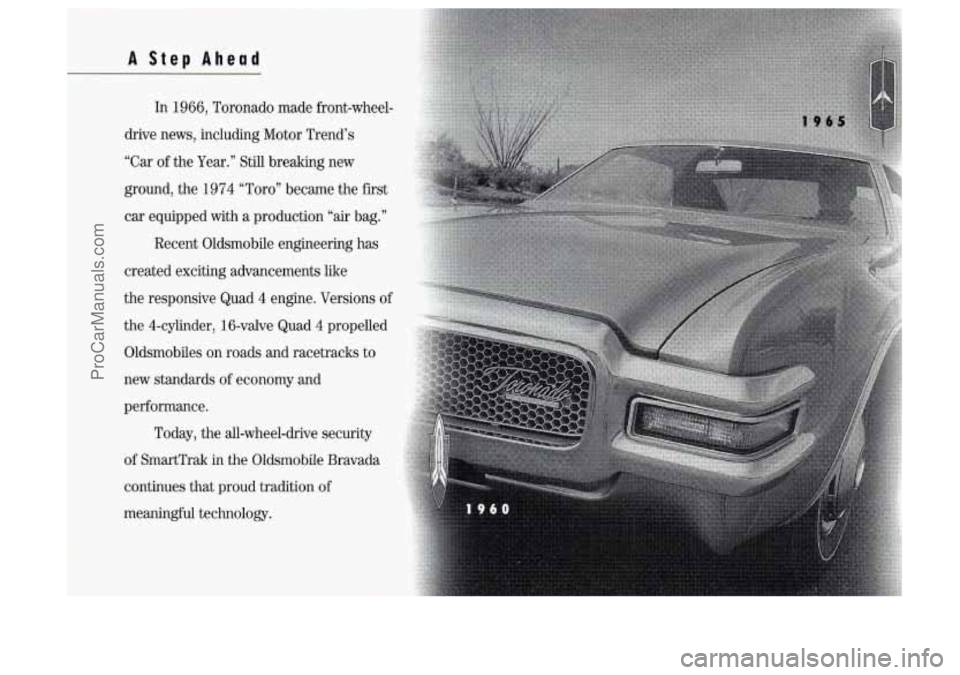
A Step Ahead
!
I
In 1966, Toronado made front-wheel-
drive news, including Motor Trend’s
“Car of the Year.’’ Still breaking new
ground, the 1974
“Toro” became the first
car equipped with
a production “air bag.”
Recent Oldsmobile engineerhg
has
created exciting advancements like
the responsive Quad
4 engine. Versions of
the 4-cylinder, 16-valve Quad 4 propelled
Oldsmobiles on roads and racetracks to
new standards
of economy and
performance. Today, the all-wheel-drive security
of SmartTrak in the Oldsmobile Bravada
continues that proud tradition
of
rneaningfid technology.
ProCarManuals.com
Page 23 of 276
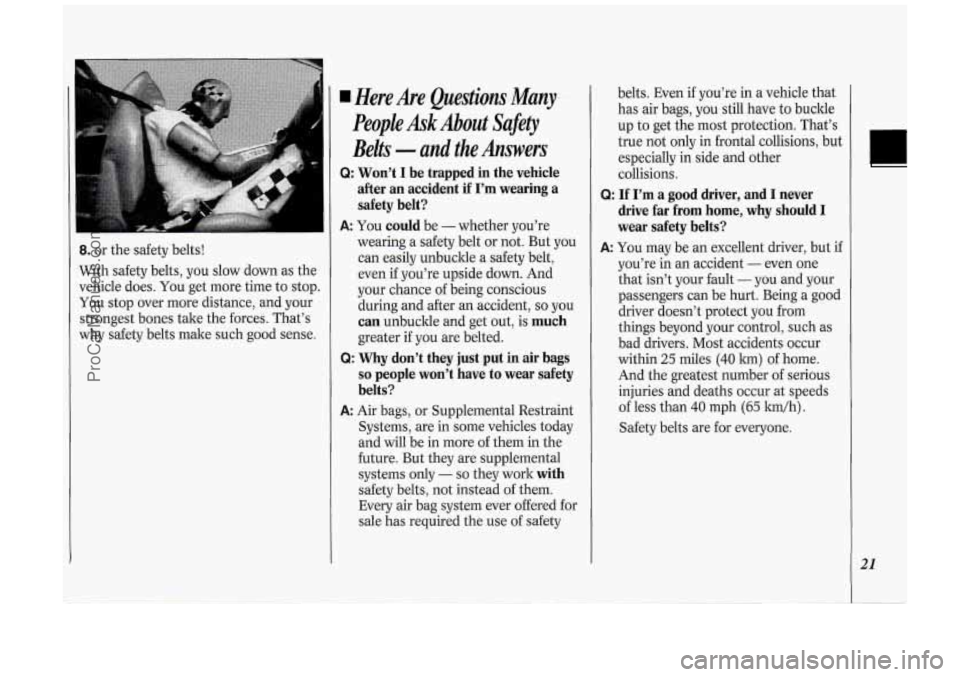
8. or the safety belts!
With safety belts, you slow down as the
vehicle does. You get more time to stop.
You stop over more distance, and your
strongest bones take the forces. That’s
why safety belts make such good sense.
I Here Are Questions Many
People
Ask About Safety
Belts
- and the Answers
Q: Won’t I be trapped in the vehicle
after an accident
if I’m wearing a
safety belt?
A: You could be - whether you’re
wearing a safety belt or not. But you
can easily unbuckle a safety belt,
even if you’re upside down. And
your chance of being conscious
during and after an accident,
so you
can unbuckle and get out, is much
greater if you are belted.
Q: Why don’t they just put in air bags
so people won’t have to wear safety
belts?
A: Air bags, or Supplemental Restraint
Systems, are in some vehicles today
and will be in more of them in the
future. But they are supplemental
systems only
- so they work with
safety belts, not instead of them.
Every air bag system ever offered for
sale has required the use of safety belts.
Even if you’re in a vehicle that
has air bags, you still have
to buckle
up to get the most protection. That’s
true not only in frontal collisions, but
especially in side and other
collisions.
drive far from home, why should I
wear safety belts?
A: You may be an excellent driver, but i
you’re in an accident
- even one
that isn’t your fault
- you and your
passengers can be hurt. Being a good
driver doesn’t protect you from
things beyond your control, such as
bad drivers. Most accidents occur
within
25 miles (40 lun) of home.
And the greatest number of serious
injuries and deaths occur at speeds
of less than
40 mph (65 lun/h) .
Safety belts are for everyone.
Q: If I’m a good driver, and I never
21
ProCarManuals.com
Page 31 of 276
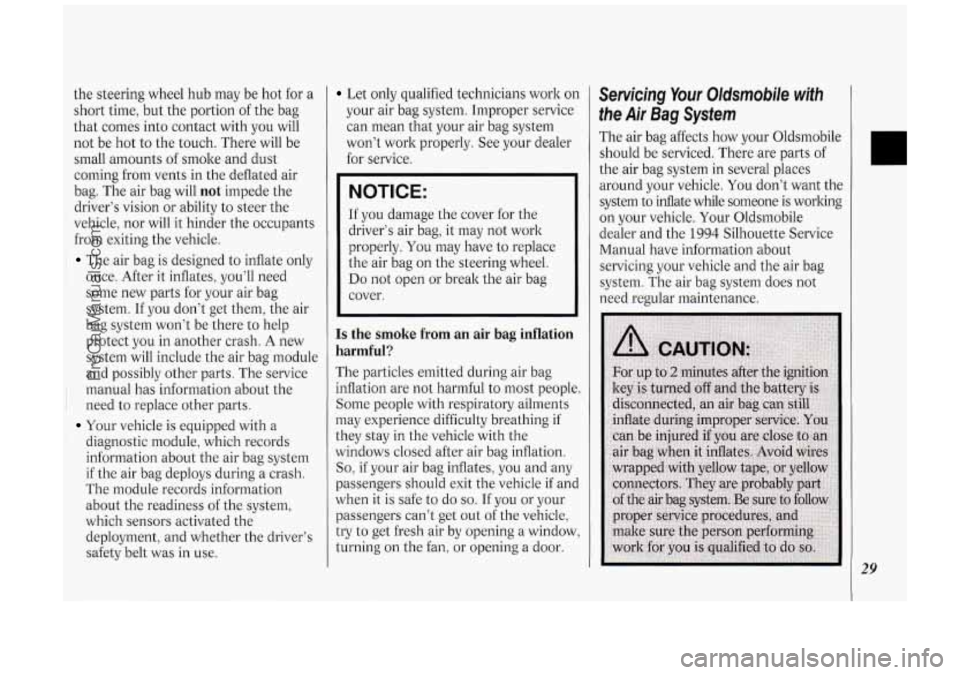
the steering wheel hub may be hot for a
short time, but the portion of the bag
that comes into contact with you will
not be hot to the touch. There will be
small amounts of smoke and dust
coming from vents in the deflated air
bag. The air bag will
not impede the
driver’s vision or ability to steer the
vehicle, nor will it hinder the occupants
from exiting the vehicle.
The air bag is designed to inflate only
once. After
it inflates, you’ll need
some new parts for your air bag
system. If you don‘t get them, the air
bag system won’t be there to help
protect you in another crash. A new
system will include the air bag module
and possibly other parts. The service
manual has information about the
i need to replace other parts.
Your vehicle is equipped with a
diagnostic module, which records information about the air bag system
if the air bag deploys during a crash.
The module records information
about the readiness of the system,
which sensors activated the
deployment, and whether the driver’s
safety belt was in use.
Let only qualified technicians work on
your air bag system. Improper service
can mean that your air bag system
won’t work properly. See your dealer
for service.
NOTICE:
If you damage the cover for the
driver’s air bag, it may not work
properly. You may have to replace
the air bag on the steering wheel.
Do not open or break the air bag
cover.
Is the smoke from an air bag inflation
harmful?
The particles emitted during air bag
inflation are not harmful to most people.
Some people with respiratory ailments
may experience difficulty breathing
if
they stay in the vehicle with the
windows closed after air bag inflation.
So, if your air bag inflates, you and any
passengers should exit the vehicle if and
when it is safe to do
so. If you or your
passengers can’t get out of the vehicle,
try to get fresh air by opening a window,
turning on the fan, or opening a door.
Servicing Your Oldsmobile with
the Air Bag System
The air bag affects how your Oldsmobile
should be serviced. There are parts of
the air bag system in several places
around your vehicle.
You don’t want the
system to inflate while someone is working
on your vehicle. Your Oldsmobile
dealer and the
1994 Silhouette Service
Manual have information about
servicing your vehicle and the air bag
system. The air bag system does not
need regular maintenance.
29
ProCarManuals.com
Page 52 of 276

Features & Controls
50
Battery Replacement
Under normal use, the batteries in your
key chain transmitter should last about
two years.
You can tell the batteries are weak if the
transmitter won‘t work at the normal
range in any location.
If you have to get
close to your vehicle before the
transmitter works, it’s probably time
to
change the batteries.
To Replace Batteries in the Remote
Lock Control:
1. Insert a coin into the slot in the back
of the transmitter, and turn
counterclockwise to open the cover.
2. Remove the cover.
3. Remove and replace the two 3-volt
batteries
(DL 20 16).
4. Reassemble the transmitter.
5. Check the transmitter operation.
I Illuminated Entry System
(OPTION)
This option comes with the optional
remote lock control system.
When you open the driver’s door, by
itself or in combination with any
passenger door or the liftgate, the
interior lights will come on and then
gradually dim to off
10 seconds after the
kt door is closed.
(If the driver’s door
has not been opened, the interior lights
will immediately dim to off.)
When you press
a on your remote
transmitter, the lights inside your
vehicle will go on, then gradually dim to
off after about
40 seconds, unless a
door or the liftgate is opened.
When you turn on the ignition, the
interior lights will immediately dim to
off. Vehicle
theft is big business, especially
in some cities. Although your
Oldsmobile has a number of theft
deterrent features, we know that
nothing we put
on it can make it
impossible to steal. However, there are
ways you can help.
Key in the Ignition
If you walk away from your vehicle with
the keys inside, it’s an easy target for
joy riders or professional thieves
- so
don’t do it.
When you park your Oldsmobile and
open the driver’s door, you’ll hear a
chime reminding you to remove your
key from the ignition and take it with
you. Always do this. Your steering
wheel will be locked, and
so will your
ignition and transaxle. And remember
to lock the doors.
ProCarManuals.com
Page 77 of 276

Push the -:a- switch to turn on the
headlights, kogether with:
Parking Lights
Side Marker Lights
Taillights
Instrument Panel Lights
Pull the switch to turn off the lights.
Operation of Lights
Although your vehicle’s lighting system
(headlights, parking lights, fog lamps,
side marker lights and taillights) meets
all applicable federal lighting
requirements, certain states and
provinces may apply their own lighting
regulations that may require special
attention before you operate these
lights.
For example, some jurisdictions may
require that you operate your fog lamps
only when your lower beam headlights
are also on, or that headlights be turned
on whenever you must use your
windshield wipers.
In addition, most
jurisdictions prohibit driving solely with
parking lights, especially at dawn or
dusk. It is recommended that you check
with your
own state or provincial
highway authority for applicable
lighting regulations.
Lights On Reminder
If you turn the ignition key to the Off or
Lock position while leaving the lights
on, you will hear
a warning chime.
Headlight High-Low Beam
Changer
To change the headlights from high to
low beam, or low to high, simply pull
the turn signal lever all the way toward
you. Then release it.
When the high beams are
on, a blue
light on the instrument cluster also will
be on.
75
ProCarManuals.com
Page 130 of 276
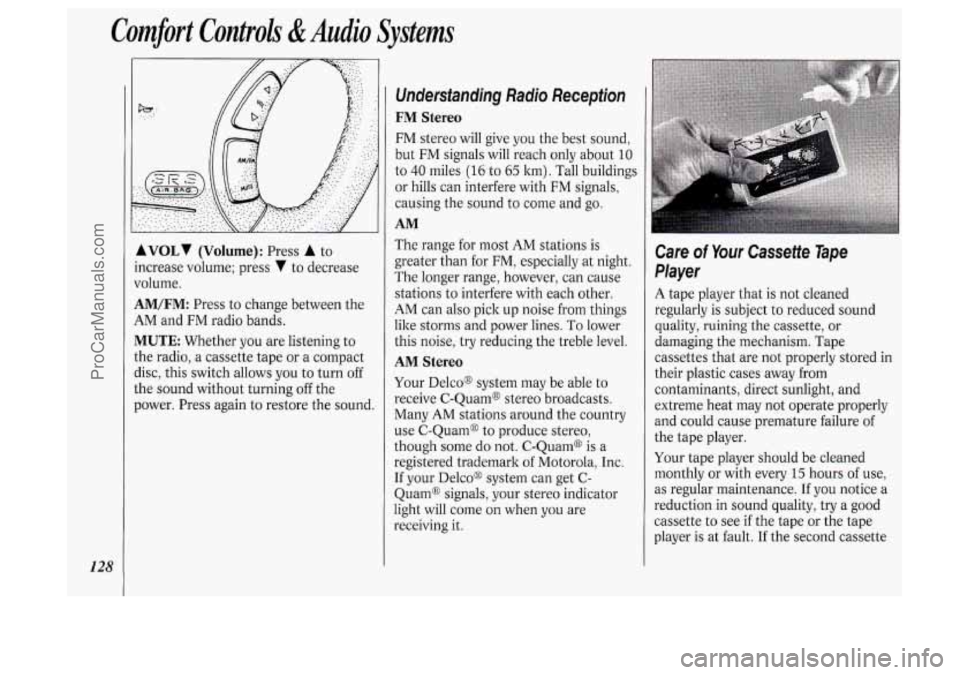
Comfort Controls &Audio Systems
128
AVOLI (Volume): Press A to
ncrease volume; press
V to decrease
Jolume.
4M/FM: Press to change between the
4M and FM radio bands.
MUTE Whether you are listening to
:he radio, a cassette tape or a compact
lisc, this switch allows
you to turn off
;he sound without turning off the
lower. Press again to restore the sound.
Undersfanding Radio Reception
FM Stereo
FM stereo will give you the best sound,
but FM signals will reach only about
10
to 40 miles (16 to 65 km). Tall buildings
or hills can interfere with FM signals,
causing the sound to come and go.
AM
The range for most AM stations is
greater than for
FM, especially at night.
The longer range, however, can cause
stations to interfere with each other.
AM can also pick up noise from things
like storms and power lines.
To lower
this noise, try reducing the treble level.
AM Stereo
Your Delcoo system may be able to
receive C-Quam@ stereo broadcasts.
Many
AM stations around the country
use C-Quam@ to produce stereo,
though some
do not. C-Quam@ is a
registered trademark of Motorola, Inc.
If your Delco@ system can get C-
Quam@ signals, your stereo indicator
light will come
on when you are
receiving it.
Care of Your Cassette Tape
Player
A tape player that is not cleaned
regularly is subject to reduced sound
quality, ruining the cassette, or
damaging the mechanism. Tape
cassettes that are not properly stored in
their plastic cases away from
contaminants, direct sunlight, and
extreme heat may not operate properly
and could cause premature failure
of
the tape player.
Your tape player should be cleaned
monthly or with every
15 hours of use,
as regular maintenance. If you notice a
reduction in sound quality, try a good
cassette to see
if the tape or the tape
player is at fault.
If the second cassette
ProCarManuals.com
Page 136 of 276

Your Driving and the Road
134
know. Medical research shows that
alcohol in
a person’s system can make
crash injuries worse. That’s especially
true for brain, spinal cord and heart
injuries. That means that if anyone who
has been drinking
- driver or
passenger
- is in a crash, the chance of
being killed or permanently disabled is
higher than if that person had not been
drinking. And we’ve already seen that
the chance
of a crash itself is higher for
drinking drivers. I Control of a Vehicle
~~
You have three systems that make your
vehicle go where
you want it to go.
They are the brakes, the steering and
the accelerator.
All three systems have
to do their work at the places where the
tires meet the road.
Sometimes, as when you’re driving on
snow or ice, it’s easy to ask more of
those control systems than the tires and
road can provide. That means
you can
lose control
of your vehicle.
I Braking
Braking action involves perception
time
and reaction time.
First, you have to decide to push on the
ProCarManuals.com
Page 139 of 276
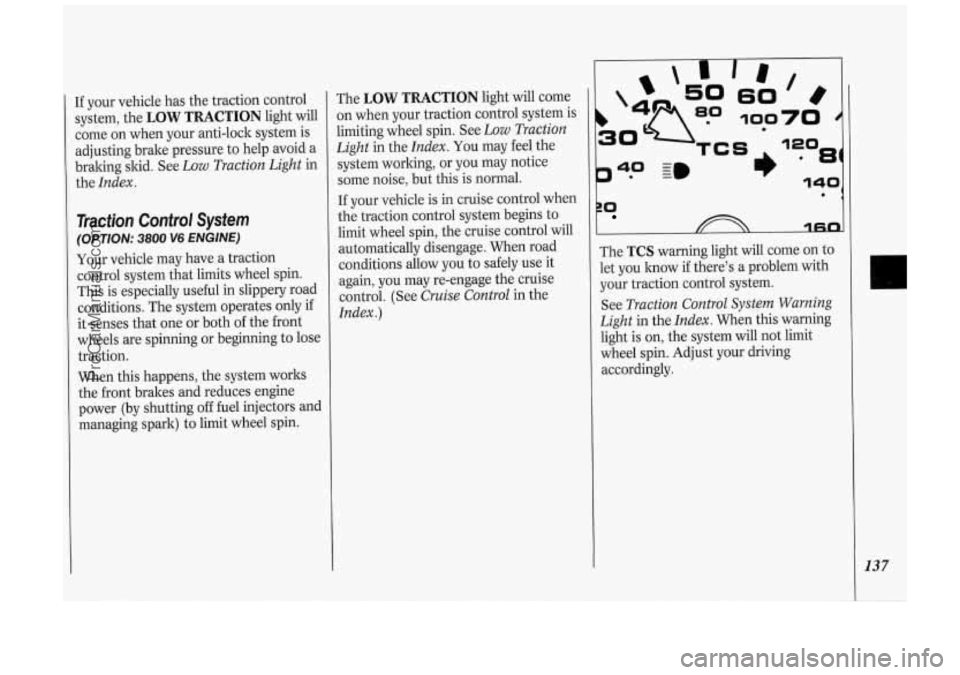
If your vehicle has the traction control
system, the
LOW TRACTION light will
come on when your anti-lock system is
adjusting brake pressure to help avoid a
braking skid. See Low Traction Light in
i
theIndex.
Traction Control System
(OPTION: 3800 V6 ENGINE)
Your vehicle may have a traction
control system that limits wheel spin.
This is especially useful in slippery road
conditions. The system operates only if
it senses that one or both
of the front
wheels are spinning or beginning to lose
traction.
When this happens, the system works
the front brakes and reduces engine
power (by shutting
off fuel injectors and
managing spark) to limit wheel spin. The
LOW TRACTION light
will come
on when your traction control system is
limiting wheel spin. See Low Traction
Light in the Index. You may feel the
system working, or you may notice
some noise, but this is normal.
If your vehicle is in cruise control when
the traction control system begins to
limit wheel spin, the cruise control will
automatically disengage. When road
conditions allow you to safely use it
again, you may re-engage the cruise
control. (See Cruise Control in the
Index
.)
30
140 0
10
4F;n
The TCS warning light will come on to
let you know if there's a problem with
your traction control system.
See Traction Control System Warning
Light in the Index. When this warning
light is on, the system will not limit
wheel spin. Adjust your driving
accordingly.
137
ProCarManuals.com
Page 140 of 276

Your Driving and the Road
138
I’he traction control system
mtomatically comes
on whenever you
start your vehicle.
To limit wheel spin, especially in
slippery road conditions, you should
dways leave the system on. But you can
:urn the traction control system off if
IOU ever need to. (You should turn the
;ystem off
if your vehicle ever gets stuck
n sand, mud, ice or snow. See Rocking
Your Vehicle in the Index.)
To turn the system off, press the switch
ocated on the center instrument panel
:onsole.
The light on the switch will go
off. If the
Lraction control system is limiting wheel
;pin when you press the switch, the
;ystem won’t turn
off right away. It will wait until
there’s
no longer a current
need to limit wheel spin.
You can turn the system back on at any
time by pressing the switch again. The
light
on the switch should come on.
Braking in Emergencies
Use your anti-lock braking system when
you need to. With anti-lock, you can
steer and brake at the same time.
In
many emergencies, steering can help
you more than even the very best
braking.
Steering
Power Steering
If you lose power steering assist
because the engine stops or the system
is not functioning, you can steer but it
will take much more effort.
Steering Tips
Driving on Curves
It’s important to take curves at a
reasonable speed.
A lot of the “driver lost control”
accidents mentioned on the news
happen
on curves. Here’s why:
Experienced driver or beginner, each of
us is subject to the same laws of physics
when driving
on curves. The traction of
the tires against the road surface makes
it possible for the vehicle to change its
path when you turn the front wheels. If
there’s
no traction, inertia will keep the
vehicle going in the same direction.
If
you’ve ever tried to steer a vehicle on
wet ice, you’ll understand this.
The traction you can get in a curve
depends
on the condition of your tires
and the road surface, the angle at which
the curve is banked, and your speed.
While you’re in a curve, speed
is the one
factor you can control.
Suppose you’re steering through a
sharp curve. Then you suddenly
accelerate. Both control systems
-
steering and acceleration - have to do
their work where the tires meet the
road. Unless you have traction control
and the system is on, adding the sudden
acceleration can demand too much
of
those places. You can lose control.
ProCarManuals.com
Page 142 of 276
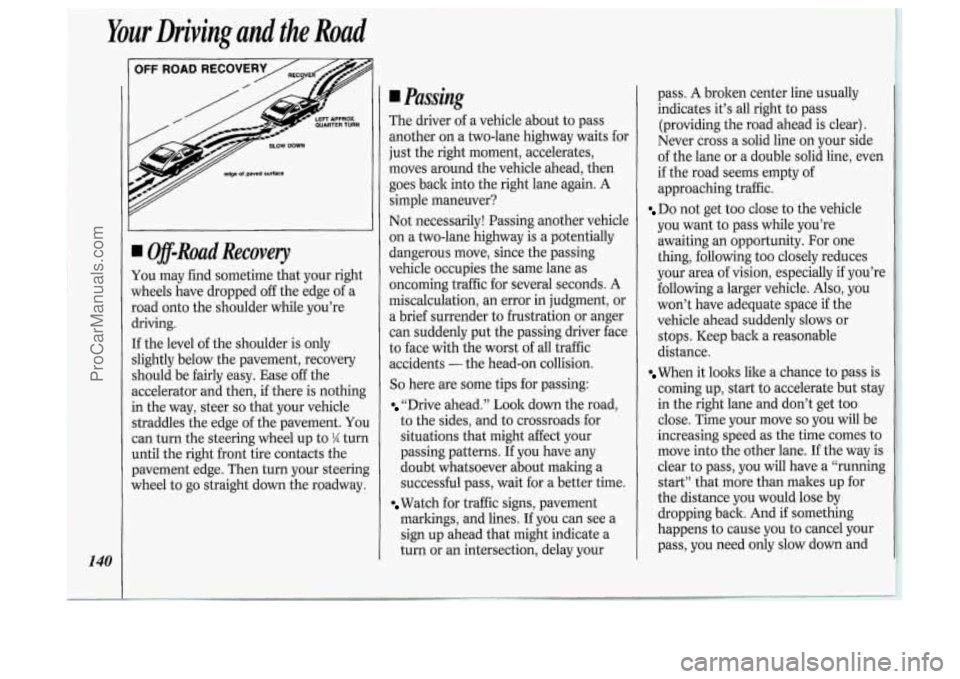
Your Driving and the Road
140
I
I Off-Road Recovery
You may find sometime that your right
wheels have dropped off the edge of a
road onto the shoulder while you’re
driving.
If the level of the shoulder is only
slightly below the pavement, recovery
should be fairly easy. Ease off the
accelerator and then, if there is nothing
in the way, steer
so that your vehicle
straddles the edge of the pavement.
You
can turn the steering wheel up to % turn
until the right front tire contacts the
pavement edge. Then turn your steering
wheel to go straight down the roadway.
I Passing
The driver of a vehicle abor It t o pass
another on a two-lane highway waits for
just the right moment, accelerates,
moves around the vehicle ahead, then
goes back into the right lane again.
A
simple maneuver?
Not necessarily! Passing another vehicle
on a two-lane highway is a potentially
dangerous move, since the passing
vehicle occupies the same lane as
oncoming traffic for several seconds.
A
miscalculation, an error in judgment, or
a brief surrender to frustration or anger
can suddenly put the passing driver face
to face with the worst of all traffic
accidents
- the head-on collision.
So here are some tips for passing:
“Drive ahead.” Look down the road,
to the sides, and to crossroads for
situations that might affect your
passing patterns. If you have any
doubt whatsoever about malting a
successful pass, wait for a better time.
markings, and lines. If you can see
a
sign up ahead that might indicate a
turn or an intersection, delay your
Watch for traffic signs, pavement pass.
A broken
center line usually
indicates it’s all right to pass
(providing the road ahead is clear).
Never cross a solid line on your side
of the lane or a double solid line, even
if the road seems empty of
approaching traffic.
Do not get too close to the vehicle
you want to pass while you’re
awaiting an opportunity. For one
thing, following too closely reduces
your area of vision, especially if you’re
following a larger vehicle. Also, you
won’t have adequate space if the
vehicle ahead suddenly
slows or
stops. Keep back a reasonable
distance.
When it looks like a chance to pass is
coming up, start to accelerate but stay
in the right lane and don’t get too
close. Time your move
so you will be
increasing speed as the time comes to
move into the other lane. If the way is
clear to pass, you will have
a “running
start” that more than rnaltes
up for
the distance you would lose by
dropping back. And if something
happens to cause you to cancel your
pass, you need only slow down and
ProCarManuals.com